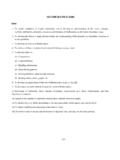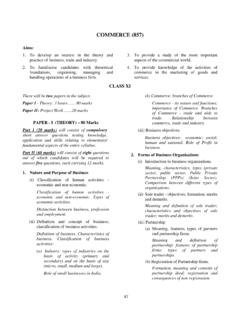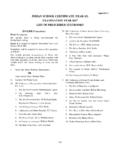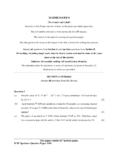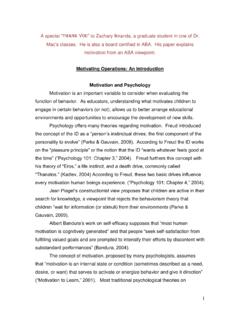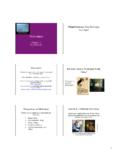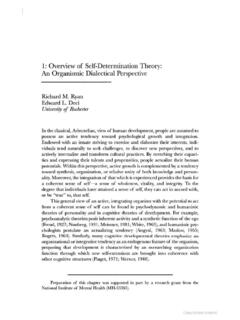Transcription of PSYCHOLOGY - CISCE
1 73 PSYCHOLOGY (855) Aims: (i) To develop an understanding of human behaviour: the nature of individuals and of members of social groups. (ii) To develop an understanding of the methods of research and study employed in PSYCHOLOGY . (iii) To develop an appreciation of the practical value of PSYCHOLOGY and its applications in daily XI There will be two papers in the subject: Paper I - Theory: 3 hours ..70 marks Paper II- Practical Work: ..30 marks PAPER - I (THEORY) 70 Marks Part I (20 marks) will consist of compulsory short answer questions relating to the fundamental aspects of the entire syllabus. Part II (50 marks) will consist of two sections, A and B. Candidates will be required to answer two out of three questions from Section A and three out of five questions from Section B.
2 Each question in this part shall carry 10 marks. SECTION A 1. The Subject PSYCHOLOGY (i) Definition of PSYCHOLOGY ; Nature bio science, social science or pure science; schools of thought Structuralism, Functionalism, Behaviourism, Psychoanalysis, Gestalt PSYCHOLOGY . Definition of PSYCHOLOGY , meaning of the terms behaviour, stimulus and response. Subject matter / nature of PSYCHOLOGY as a bio science, social science or pure science. The eclectic approach of modern PSYCHOLOGY . Main features of the schools of Structuralism, Functionalism and Behaviourism, Psychoanalysis, Gestalt PSYCHOLOGY (two Psychologists of each approach and their relevant concepts).
3 (ii) Fields of PSYCHOLOGY clinical, counselling, developmental, educational, organizational and social. The general importance and aims of studying PSYCHOLOGY and its special benefits. Applications - different branches and the kind of work done in special fields - clinical, counselling, developmental, educational, organizational and social (in brief). (iii) Heredity and Environment meaning of the term heredity ; basic principles and mechanism of heredity (genetic). Meaning of the term environment ; importance of both heredity and environment in behaviour. The definition and role of chromosomes and genes (dominant and recessive); the laws of heredity: uniformity and variability.
4 Significance of environment: physical and social. Heredity related diseases: Mental Retardation and Huntington s disease. How both heredity and environment interact to produce behaviour (Twin studies, Adoption Studies, Separated Twin Study). 2. Methods of PSYCHOLOGY (i) Scientific Methods in PSYCHOLOGY -observation, case study, surveys, psychological tests, experimentation steps. Psychological tests and their uses. The application of scientific methods in the study of behaviour. What is meant by scientific observation? Field study; controlled and uncontrolled observation; longitudinal and cross-sectional studies; the case history method; the experimental method - variables and controls - steps in an experiment; surveys and use of questionnaires/self reports.
5 One advantage and one disadvantage for each method of PSYCHOLOGY . Meaning of samples (random, biased, representative); meaning of population. Psychological tests characteristics, definition, uses and types. (ii) Interpretation of research results use of statistics in interpretation of data -understanding of why statistics is used 74 (descriptive & inferential). Basic statistical concepts statistics, sample, population. Why statistics is used in PSYCHOLOGY - interpretation of findings: describing and summarizing data, comparing individuals/ groups, investigating relationships between variables, predicting. Descriptive statistics - for summarizing scores. Inferential statistics - to determine whether observed differences between groups are likely/unlikely to have occurred by chance.
6 How scores are grouped into frequency distributions; central tendency of a frequency distribution - mean, median, mode and when each measure is used; dispersion: the extent to which scores are spread out - range, variance, standard deviation; why both central tendency and variability are important in PSYCHOLOGY . 3. Attention and Perception (i) Nature of attention - its inner and outer determinants. The importance of attention in perception - how both physical factors such as size, colour, movement, change, intensity, contrast and psychological factors such as need, interest and emotion determine attention and perception. (ii) Perceptual processes - difference between sensation and perception.
7 Organizational principles of perception - laws, constancies, depth and colour perception. Process involved in transforming sensation to perception. Important factors in perceptual process - figure and ground, laws of grouping: similarity, proximity, continuation, simplicity, good figure; constancy of size, shape and colour; factors involved in depth perception -monocular and binocular cues; how colour is perceived - biological and psychological factors ; attributes of colour - hue, wavelength, brightness and saturation; laws of colour mixture; colour blindness, adaptation and after-images. (iii) Errors in perception - illusions of size and shape; what is meant by extra-sensory perception (ESP).
8 False interpretations - illusions: Muller-Lyer, Height -Width, Ponzo, Zoellner, Poggendorf (details of experiments are required); ESP - perceptions not based on any of the known senses (general understanding of ESP). SECTION B 4. Emotions and Motivation (i) What is meant by emotion; the basic emotions. Subjective and cognitive experience, physiological basis of emotion, reactions and overt expression. Primary emotions - fear, anger, joy, sorrow, affection. (ii) Theories of emotion dealing with physiological, subjective and cognitive aspects. James Lange, Cannon Bard, Schachter - Singer theories. (iii) What is meant by motives, needs and instincts. Motivation as an internal force generating certain behaviour - biological needs and homeostasis; instincts as unlearned and physiological desires; evidence indicating the existence of unconscious motives.
9 Intrinsic - the desire to perform activities for their own sake. (iv) Theories of Motivation. Pull and push theories, Optimum Arousal theory and Expectancy theory - Graphic representation of Maslow's Needs Hierarchy. (v) Social motives. Three distinctively human motives: Achievement - accomplishing difficult tasks; Power - exerting influence over others; Aggression - learning and control of human aggression, causes and effects. (vi) Frustration - blocking of motives; conflict among motives. Frustration as a result of motives not finding free or adequate expression. Different types of conflict among motives: approach-approach, avoidance-avoidance, multiple approach-avoidance (with examples).
10 75 5. Learning (i) What is meant by learning; how learning takes place - Classical and Operant Conditioning; Insight learning, Observational Learning and Learning Styles. Definition of learning - Pavlov and Classical Conditioning; Thorndike and Trial and Error; skinner and Operant Conditioning; experiments, findings and principles established. Insight and Observational Learning - Kohler and bandura 's studies. Learning Styles Auditory, Visual and Kinesthetic. (ii) Learning disabilities: definition and types. Characteristics of the disabilities - Dyslexia, dyscalculia, dysgraphia, dyspraxia (symptoms and management).



